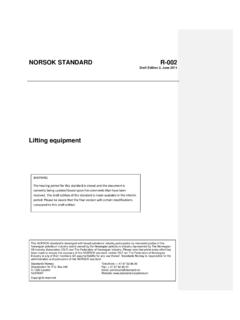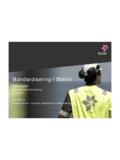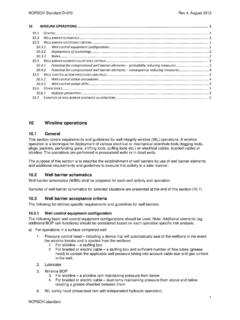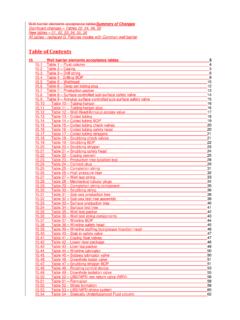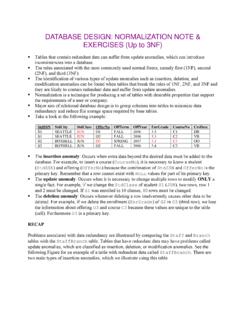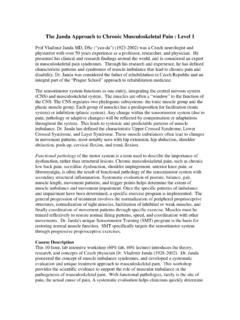Transcription of NORSOK Standard D -010 Rev. 4 (15.8.12) The table …
1 NORSOK Standard D-010 Rev. 4 ( ) The table below shows where and how NORSOK D-010 rev. 4 responds to the recommendations in the OLF s Summary report to Deepwater Horizon (Macondo) accident. Color denotes that OLF ; 1 : is fully complied with. No further enhancement required. 2: is partially complied - further enhancement is required. 3: is not complied with, Reason and action is stated in the table . # OLF recommendations NORSOK D-010, ( ) 1 NORSOK D-010 should be updated to include the term critical cement job . A requirement for independent design verification of critical cement jobs should also be introduced. This verification can be performed by either an independent in-house department or an external third party. EAC table 22, Casing Cement: : For critical cement jobs, HPHT conditions and complex slurry designs the cement program should be verified internally or by a third party company.
2 Comment: Critical cement job is not defined evaluate if this should be defined. 2 NORSOK D-010 should furthermore require that cement and casing design for slurries placed across hydrocarbon zones be verified in cementing company labs prior to use. For critical slurry designs, such as those containing foam cement or gas block additives, the slurry design, slurry properties, waiting on cement times and cementing plan should be independently verified. This verification can be performed by either an independent in-house department or an external third party. EAC table 22, Casing Cement: D: Specific requirements for logging (critical cement jobs): For development wells; The production casing/liner shall be logged to ensure sufficient cement above the reservoir and production packer if: the production casing/liner is set into/through the reservoir, the intermediate casing does not have sufficient formation integrity to withstand reservoir pressure.
3 For injection wells with higher pressure than the cap rock integrity, the cement shall provide hydraulic isolation from the upper most injection point to a minimum of 30 mMD cumulative verified (logged) cement above top reservoir. For permanent P&A where the same casing cement job defines both the primary and secondary barrier function, the casing cement shall be verified by logs. Comment: Include verification by lab testing of cement slurries placed across hydrocarbon zones NORSOK Standard D-010 Rev. 4 ( ) # OLF recommendations NORSOK D-010, ( ) 3 a) NORSOK D-010 should be updated to define the requirements related to inflow (negative) pressure testing clearly. b) Well programmes should provide a detailed procedure and acceptance criteria for all inflow tests. Inflow tests should be conducted in a controlled manner with detailed procedures which have been approved by an authorized person, and accompanied by a demonstrated risk analysis.
4 This should be covered in NORSOK D-010 Pressure test direction The test pressure should be applied in the direction of flow. If this is not possible or introduces additional risk, the test pressure can be applied against the direction of flow, providing that the well barrier element is constructed to seal in both flow directions. Inflow testing during drilling and well activities An inflow (negative pressure) test shall be described in a detailed procedure, which should contain the following information: a) an identification of the well barriers to be tested, b) identification of the consequences of a leak, c) the risk of inconclusive results due to large volumes, temperature effects, migration, etc, d) a plan of action in the event that leak occurs or if the test is inconclusive, e) a schematic diagram showing the configuration of test lines and valve positions, f) all operational steps and decision points, g) defined acceptance criteria for the test, h) verification of the secondary well barrier s ability to withstand differential pressure.
5 The following apply for the execution of an inflow test: i) Volume and pressure control shall be maintained at all times during displacement and testing. j) During inflow testing it shall be possible to displace the well to back overbalanced fluid at indication of flow or in case of inconclusive results. k) During displacement, non shearable components shall not be placed across the BOP shear ram. l) Displacement to a lighter fluid should be performed with constant bottom hole pressure. m) When the displacement is complete, the well shall be closed in without reducing the bottom hole pressure. n) The inflow test should be performed by bleeding down pressure in steps, to a pre-defined differential pressure. o) The pressure development should be monitored for a specified time period for each step. 4 NORSOK D-010 should be further clarified to state that, when changing out the fluid barrier element while the remaining barrier consists of untested cement or mechanical plugs, all displacement to a lighter underbalanced fluid should be done with a closed BOP and through the choke and kill lines.
6 See response above (#4) NORSOK Standard D-010 Rev. 4 ( ) # OLF recommendations NORSOK D-010, ( ) 5 NORSOK D-010 should be updated to include descriptive values for full/partial/seepage and static/dynamic fluid losses so that deviations in return flow can be reported using a common frame of reference. Such data can be used to generate acceptable downhole loss rates for specific fields. EAC table 22, Casing Cement: 100% displacement efficiency (according to simulated plan) and excess volume and stand-off according to requirement. In case of losses, it shall be documented that the loss zone is above required TOC. When the cement job shall be used as a barrier for the operational phase or P&A in case of losses, it shall be documented that the loss zone is above required TOC. Acceptable documentation in case of losses are logs or job record comparison with similar loss case(s) on reference wells.
7 Comment: Descriptive values ( 1,5 m3/hr) has been evaluated, but discarded as it is very difficult to set specific values based on objective/logical argumentation. 6 N/A 7 OLF recommends that well control bridging documents be prepared for all future drilling operations. (OLF issued this recommendation to Norwegian operators and contractors in January 2011. It has also been referred to the NORSOK D-010 revision committee.) Well control action procedures and drills There shall be a plan for activating well barrier(s)/well barrier elements (well control action procedure), prior to commencement of all well activities and operations. These plans shall be made known to all involved personnel. A well control bridging document between Operator and Contractor shall be prepared defining: a) Well control roles and responsibilities during the operation b) Shut-in procedures c) Methods for re-establishing barriers: Activation of alternative well barrier elements/envelopes Kill procedures Normalization d) Specific well control configuration for the well activity (including ram configuration) 8 N/A 9 The need for more practice with well control emergencies is recognised.
8 NORSOK D-010 should be updated to include requirements for routine well control exercises, specifically in the areas of: - spacing out and centralising pipe prior to shearing and disconnecting - diverter line-up to overboard lines - well control exercises to be conducted (scope, frequency, acceptance, etc). Well control action drills The following well control action drills should be performed: (See this chapter table too large to insert here) NORSOK Standard D-010 Rev. 4 ( ) # OLF recommendations NORSOK D-010, ( ) 10 NORSOK D-010 should specify and require periodic testing of emergency subsea well control activation systems, with due regard to operational activities. Annex A, table : NOTE 4 If the BOP is located at sea bed, the function testing shall also include function testing of the acoustic system. 11 NORSOK D-001 and D-010 should include more explicit requirements for primary and back-up BOP control systems, their ability to perform in emergencies and testing of them.
9 Not addressed as this belongs in D-001. 12 N/A 13 Operators should conduct a risk assessment to determine the optimum BOP configuration for each well, utilising the latest BOP reliability, performance and assessment data, the design of the well to be drilled, and the rig in use. The findings should be recorded in the well control bridging document. Well barrier elements acceptance criteria: A risk analysis shall be performed to decide the best BOP configuration for the location. The risk analysis should take the following into account: a) Position of different ram types b) Choke and kill line access position c) Ability to hang off pipe and retain ability to close shear ram, including contingency closure of rams if available d) Ability to centralize pipe prior to closing shear ram e) Back-up shear ram EAC Drilling BOP: 2. A risk analysis shall be performed to decide upon the best BOP configuration for the location in question. 14 N/A 15 NORSOK D-001 should be updated to ensure that subsea wellhead casing/tubing hangers are locked down on all strings in contact with hydrocarbon-bearing zones.
10 EAC table 2 Casing, C 5.: Casing hangers shall have adequate lockdown capacity to guarantee seal integrity during normal working loads as well as well control situations. Comment: Move this to EAC table 12 Wellhead (which includes hangers). Consider rewording to instruct that hangers shall be locked down. 16 to 18 N/A 19 A recommendation on management of change (MOC) should be implemented in NORSOK D-010 as follows: a) An MOC procedure covering the well life cycle should be included in the operator s management system steering documentation. The MOC procedure should describe the Management of change A Management of Change (MoC) procedure covering the life cycle of the well shall be implemented. The procedure should describe the processes used to assess risk, mitigate, authorize, and document technical, operational or organizational changes to previously approved information or procedures. Changes subject to a MoC process should include the NORSOK Standard D-010 Rev.

